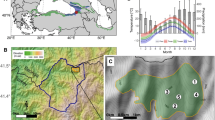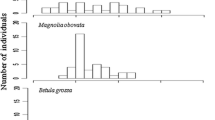Abstract
Typhoon no. 19 of 1991 (T9119) caused multiple treefalls and created large openings in an old-growth beech (Fagus crenata) forest at Mt. Daisen, in the Daisen Forest Reserve, southwestern Japan. The area of the largest opening was about 1.7 ha (300 m by 70 m). To predict the dynamics of the beech stand after the disturbance of T9119, we investigated the damage to the stand and the density and growth rate of trees with DBH=5–10 cm in a 1-ha plot covering a large part of the largest opening and the adjacent closed canopy.
The beech did not regenerate immediately. The regeneration and growth rate of trees with DBH=5–10 cm were related to the frequency of the typhoon attack for at least the past century. In beech forests, small gap formation is the prevailing mode of disturbance. Our results indicate that typhoons affect the structure and dynamics of this beech stand. We suggest that both small gap formation and large-scale disturbance are important for the maintenance of beech forest in some areas.
Similar content being viewed by others
References
Abrams M.D. &Orwig D.A. (1996): A 300-year history of disturbance and canopy recruitment for co-occurring white pine and hemlock on the Allegheny plateau, USA.J. Ecol. 84: 353–363.
Bellingham P.J., Kohyama T. &Aiba S. (1996): The effects of a typhoon on Japanese warm temperate rainforests.Ecol. Res. 11: 229–247.
Bormann F.H. &Likens G.E. (1979):Pattern and process in a forested ecosystem. Springer-Verlag, New York.
Boose E.R., Foster D.R. &Fluet M. (1994): Hurricane impacts to tropical and temperate forest landscapes.Ecol. Monogr. 64: 369–400.
Brokaw N.V.L. (1985): Treefalls, regrowth, and community structure in tropical forests. In:Pickett S.T.A. &White P.S. (eds.),The ecology of natural disturbance and patch dynamics, Academic Press, London, pp. 53–69.
Dunn C.P., Guntenspergen G.R. &Dorney J.R. (1983): Catastrophic wind disturbance in an old-growth hemlock-hardwood forest, Wisconsin.Canad. J. Bot. 61: 211–217.
Emborg J., Christensen M. &Heilmann-Clausen J. (2000): The structural dynamics of Suserup Skov, a near- natural temperate deciduous forest in Denmark.Forest Ecol. Managem. 126: 173–189.
Ferguson B.G. (1995): Recruitment and decay of a pulse of Cecropia in Nicaraguan rain forest damaged by hurricane Joan: Relation to mutualism with Azteca ants.Biotropica 27: 455–460.
Foster D.R. (1988): Species and stand response to catastrophic wind in central New England, U.S.A.J. Ecol. 76: 135–151.
Hara M. (1985): Forest response to gap formation in a climax beech forest.Jap. J. Ecol. 35: 337–343.
Hashizume H. (1994): On the forest damage caused by Typhoon No. 19 in 1991.Res. Bull. Tottori Univ. Forests 22: 1–15 (In Japanese with English summary).
Henry J.D. &Swan J.M.A. (1974): Reconstructing forest history from live and dead plant materia — an approach to the study of forest succession in southwest New Hampshire.Ecology 55: 772–783.
Ida H. (2000): Treefall gap disturbance in an old-growth beech forest in southwestern Japan by a catastrophic typhoon.J. Veg. Sci. 11: 825–832.
Ida H. &Nakagoshi N. (1998): a large gap formation in a beech forest on Mt. Garyu in southwestern Japan by Typhoon 9119.J. Sustainable Forest. 6: 237–250.
Lorimer C.G. (1989): Relative effects of small and large disturbances on temperate hardwood forest structure.Ecology 70: 565–567.
Lolimer C.G. &Frelich L.E. (1989): A methodology for estimating canopy disturbance frequency and intensity in dense temperate forests.Canad. J. Forest Res. 19: 651–663.
Marks P. L. (1974): The role of pin cherry (Prunus pensylvanica L.) in the maintenance of stability in northern hardwood ecosystems.Ecol. Monogr. 44: 73–88.
Meteorological Business Support Center (1998):The encyclopedia of typhoons. Maruzen, Tokyo (In Japanese).
Naka K. (1982): Community dynamics of evergreen broadleaf forests in southwestern Japan. I. Wind damaged trees and canopy gaps in an evergreen oak forest.Bot. Mag. (Tokyo) 95: 385–399.
Nakashizuka T. (1989): Role of uprooting in composition and dynamics of an old-growth forest Japan.Ecology 70: 1273–1278.
Nakashizuka T. &Numata M. (1982): Regeneration process of climax beech forests. I. Structure of a beech forest with the under growth of Sasa.Jap. J. Ecol. 32: 57–67.
Nakashizuka T. &Yamamoto S. (1987): Natural disturbance and stability of forest communities.Jap. J. Ecol. 37: 19–30 (In Japanese with English summary).
Ohwi J. (1972):Flora of Japan (revised). Shinbundo, Tokyo (in Japanese).
Oliver C.D. &Stephens E.P. (1977): Reconstruction of a mixed-species forest in Central New England.Ecology 58: 562–572.
Peterson C.J. &Pickett S.T.A. (1990): Microsite and elevational influences on early forest regeneration after catastrophic windthrow.J. Veg. Sci. 1: 657–662.
Peterson C.J., Carson W.P., McCarthey B.C. &Pickett S.T.A. (1990): Microsite variation and soil dynamics within newly created treefall mounds and pits.Oikos 58: 39–46.
Pickett S.T.A. &White P.S. (eds.) (1985):The ecology of natural disturbance and patch dynamics. Academic Press, London.
Putz F.E. (1983): Treefall pits and mounds, buried seed, and the importance of soil disturbance to pioneer trees on Barro Colorado Island, Panama.Ecology 64: 1069–1074.
Putz F.E. &Sharitz R.R. (1991): Hurricane damage to old-growth forest in Congaree Swamp National Monument, South Carolina, U.S.A.Canad. J. Forest Res. 21: 1765–1770.
Rebertus A.J., Kitzberger T., Veblen T.T. &Roovers L.M. (1997): Blowdown history and landscape patterns in the Andes of Tierra Del Fuego, Argentina.Ecology 78: 678–692.
Remmert H. (1991): The mosaic cycle concept of ecosystems. In:Remmert H. (ed.),The mosaic cycle concept of ecosystems, Ecol. Studies 85, Springer-Verlag, Berlin, pp. 1–21.
Robert R.A. (1964): Minimizing windfall around clear cutting in spruce-fir forest.Forest Sci. 10: 130–142.
Runkle J.R. (1981): Gap regeneration in some old-growth forests of the eastern United States.Ecology 62: 1041–1051.
Runkle J.R. (1990): Gap dynamics in an OhioAcer-Fagus forest and speculations on the geography of disturbance.Canad. J. Forest Res. 20: 632–641.
Shaetzl R.J., Johnson D.L. Burns S.F. &Small T.W. (1989): Tree uprooting: Review of terminology, process, and environmental implications.Canad. J. Forest Res. 19: 1–11.
Spies T.A. &Franklin J. F. (1989): Gap characteristics and vegetation response in coniferous forests of the Pacific Northwest.Ecology 70: 543–545.
Watt A.S. (1947): Pattern and process in the plant community.J. Ecol. 35: 1–22.
White P.S. (1979): Pattern, process, and natural disturbance in vegetation.Bot. Rev. 45: 229–299.
Yamamoto S. (1989): Gap dynamics in climaxFagus crenata forests.Bot. Mag. (Tokyo) 102: 93–114.
Zimmerman J.K., Everham III E.M., Waide R.B., Lodge D.J., Taylor C.M. &Brokaw N.V.L. (1994): Response of tree species to hurricane winds in subtropical wet forest in Puerto Rico: implications for tropical tree life histories.J. Ecol. 82: 911–922.
Author information
Authors and Affiliations
Corresponding author
Rights and permissions
About this article
Cite this article
Yamashita, A., Sano, J. & Yamamoto, SI. Impact of a strong typhoon on the structure and dynamics of an old-growth beech (Fagus crenata) forest, southwestern Japan. Folia Geobot 37, 5–16 (2002). https://doi.org/10.1007/BF02803187
Issue Date:
DOI: https://doi.org/10.1007/BF02803187




